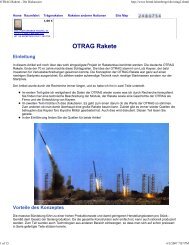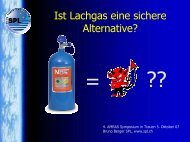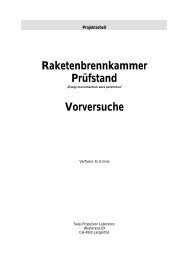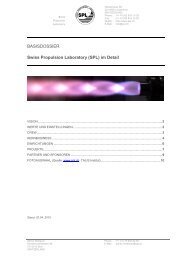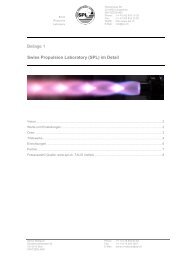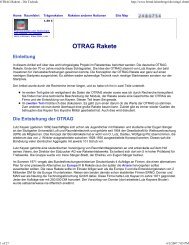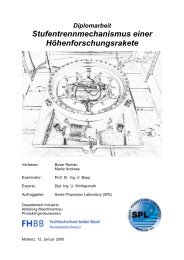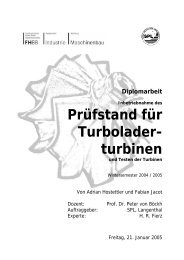Create successful ePaper yourself
Turn your PDF publications into a flip-book with our unique Google optimized e-Paper software.
any 6.te start going wrong statistically. In a reliability of 99% you would have at least the<br />
first two stages also examine the probability of two engine failures.<br />
This bill is not even considered that it will turn off when engine failure, the opposite in<br />
order to maintain the boost symmetry. Makes you double it, then the impact.<br />
Kayser gives true that the engines were qualified "6 Sigma". But these are only a criterion<br />
from the production, that indicates that you have during the preparation of a committee of<br />
about 3.4 parts per million. This does not mean that fail during the flight so few engines.<br />
Finally, there was at 18 <strong>OTRAG</strong> launches two false starts at only 4 or one engine per<br />
start. As the sum can be simplified to say that the <strong>OTRAG</strong> rocket engines with 100 times<br />
more than conventional construction also provides 100 times greater demands on the<br />
reliability of the engine. Lutz Kayser is sure that the engine is so reliable.<br />
Already formed in the control fuel residues are immense. Each rocket must be after the<br />
start of the horizontal plane be diverted to the vertical. When do you <strong>OTRAG</strong> this by<br />
shutting down the engines on one side to 40% thrust. Here, too, remain fuel residues.<br />
These are relatively large: Assuming that the same top speed as <strong>OTRAG</strong> rocket Ariane<br />
has to reach, so expect it back, that the first stage would still have about 5,000 kg residual<br />
fuel in the stage separation.<br />
<strong>OTRAG</strong> was tested systems engineering<br />
What was the <strong>OTRAG</strong> never reached the full test of a carrier. De facto, all tests are only<br />
tests of individual engines under flight conditions. In principle, we have developed a<br />
rocket height of the lower power class - but no launcher.<br />
The thrust vector control of, the shutdown of engines in case of failure, the whole scheme<br />
of hundreds of engines, the stage separation and the entire control. All this was never<br />
tested. Not for nothing was Lutz Kayser, the financial cost of developing a launch vehicle<br />
with 500 million DM. It is expected that there would be still some setbacks.<br />
In other rockets there is a big step from one engine to a reliable missile. There are, in this<br />
age of computer simulations, and even companies with decades of experience setbacks,<br />
for example, was at the Delta III, the set after 2 miscarriages and a partially successful<br />
demonstration launch.<br />
In a completely new concept to me unproven technologies, the risks are very high. Today<br />
the trend is to use less engines. Ariane 5 has only 4 engines instead of up to 10 4 in the<br />
Ariane The Delta 4 is a maximum of 6 engines instead of up to 12 2 in the Delta This is<br />
to reduce the reason the possibility of error.<br />
Control<br />
The control of the rocket as <strong>OTRAG</strong> was written by throttling an engine. It is therefore<br />
not possible to regulate the thrust arbitrarily fine but only in fixed steps. Conventional<br />
engines swing the other hand, their engines and can thus influence the direction of thrust<br />
fine.



